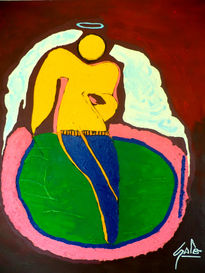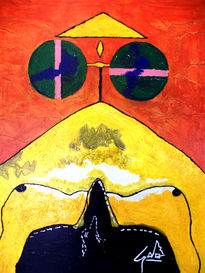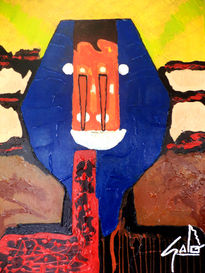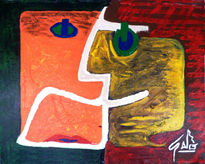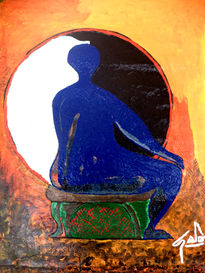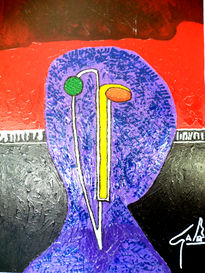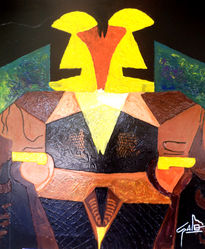Brother Oscar Galo (Curriculum Artistico)
\"The Artist Picassian more World Famous\"
________________________________________
Artist name: HNO. OSCAR GALO
Place and Date of Birth: Managua, Nicaragua, March 24, 1962
Higher Artistic Education: Self-taught Picassian Independent Artist
Professional Experience: Painter, Sculptor, Designer and Draughtsman Picassian
Solo Exhibition:
The HNO. OSCAR GALO of Nicaraguan nationality or permanent residence, is the creator and maximum exponent of his unique style and undisputed first place, is undoubtedly \"The Independent Artist Famous Picassian more Nicaragua and the World\" in the Social and Galleries on the most popular lines of modern art.
His style is not used or is chosen, is the product of your thinking, seeing, being and all that defines your style and seeks to develop theories or schools; their need was and is a break with the past and give the artwork its own internal life, thereby fusing classical art with modern or contemporary art in a simple but masterful Explosion accompanied by a brightly colored as the nature of artistic eroticism and sensuality extraordinarily beautiful beautiful beauty magical.
It is situated in the figurative but never neglects the extraordinary visual and technical contribution of so-called abstract. Tends towards a figurative schematic esquicito and sensual, a paint schematic increasingly defining, accurate, to continue the wonderful work method and deductive that were wrote and teachers gemiales example Grandey Pablo Picasso, Salvador Dali, Rufino Tamayo, Wilfredo Lam, Giorgio de Chirico, Fernand Léger, john gray, Oswaldo Guayasamin, Armando Morales and Omar d\'Leon, among Ortros.
Emphasizes ways to exalt their expressive character, and care that they gain importance in themselves, independently of each value and color (...) It is, as stated, that with lines and colors brings out the box a plane, but if it is, with the highest purity of means.
The most important issue of all his work is precisely the static on the human figure, making it timeless.
The invention of forms, problems of composition and color, rhythm, are guided in more than rules,
(1)
by emotion. Love the emotion that corrects the rule.
Considered as the most important artist Picassian XXI century and one of the most determinants of modern or contemporary painting world, is the most prolific figures today. The HNO. OSCAR is the largest GALO rupture and renewal of the arts since the Renaissance, and its presence is certainly imprescindible.Sin doubt to renewed and redefined the art (as Pablo Picasso), but as it could, could do it on his own works.
((2)
Web sites where you could see and observe the diversity of Works of Art and Videos which are the following
http://hnooscargalo.artelista.com/
https://plus.google.com/photos/115258872217082114024/albums?banner=pwa
NETWORKS
http://www.facebook.com/hnooscar.galo
https://twitter.com/HNOGALO
https://plus.google.com/u/0/115258872217082114024/posts
http://www.taringa.net/HNOOSCARGALO
GOOGLE
YOUTUBE
OSCAR HNO GALO, THROUGH Unveils Collection Art Sale 2013
http://www.youtube.com/watch?v=NJswJnl5UQA
OSCAR HNO Unveils New Collection GALO Picassiana Excellent
http://www.youtube.com/watch?v=2zhh-nc9ayE
OSCAR HNO GALO ART presents his collection of Picasso TOTAL
http://www.youtube.com/watch?v=16HD0SmeM8c
OSCAR HNO GALO Pintutas Unveils Collection UNLIMITED
http://www.youtube.com/watch?v=kRwG26tpGUk (3)
HNO. OSCAR GALO Unveils SUPREME ART Collection.
http://www.youtube.com/watch?v=aBjwKWYlnUE
HNO. Present your collection GALO OSCAR Famous Picassiana EVOLUTION
http://www.youtube.com/watch?v=s2pRKtnfCHw
HNO. GALO OSCAR PARTY Picassiana Unveils Collection TAURINA
http://www.youtube.com/watch?v=bF9UOCvMf1A
OSCAR HNO GALO, right through your Colecion Presents Art Sale 2012
http://www.youtube.com/watch?v=jbGvAGyZa0M
He says he began to draw and paint his 8 year old self-taught, ie on their own initiative and personal account, studying the style of the most famous painters and paintings, among which are;
1. PABLO PICASSO (1881-1973) - Picasso is to Art History a giant earthquake with eternal aftermaths. With the possible exception of Michelangelo (who focused his greatest efforts in sculpture and architecture), no other artist had such ambitions when placing his work within the history of art. Picasso created the avant-garde. Picasso destroyed the vanguards. He looked back at the great masters and surpassed them proposed. He faced the whole history of art and his own hand redefined the tortuous relationship between work and viewer.
Two. GIOTTO di Bondone (c.1267-1337) - It has been said that Giotto was the first real painter, like Adam was the first man. We agree first. Giotto continued the Byzantine style of Cimabue and other predecessors, but he earned the right to appear in golden letters in the history of painting works to provide a quality unknown to date: emotion.
Three. LEONARDO DA VINCI (1452-1519) - For better or worse, Leonardo will be forever known as the author of the most famous painting of all time, the Gioconda or Mona Lisa. But more than that, much more. His gaze humanist, almost scientific, entered Quattrocento art and revolutionized his sfumetto that no one was able to imitate.
April. Paul Cézanne (1839-1906) - \"Cézanne is the father of us all\". This lapidary phrase has been attributed to both Picasso and Matisse, and certainly not matter who actually said it, because in either case is true. Based on the wave of fresh air representing Impressionism, Cézanne left behind the entire group to develop a style of painting never seen to date, which opened the door wide for the arrival of Cubism and the rest of the twentieth century avant-garde
May. Rembrandt Van Rijn (1606-1669) - The fascinating, magnetic play of light and shadows of his works seem a reflection of his life, moving from fame to oblivion while his technique did nothing but improve. His self-portraits, the most fascinating long history of painting, we speak of a sincere and honest painter, a teacher able to penetrate the mind of the greatest unknown: Self
June. DIEGO VELAZQUEZ (1599-1660) - Along with the above, one of the summits of Baroque painting. But unlike the Dutch, the Sevillian artist moved most of his life within the comfortable, but rigid court society. Nonetheless, Velázquez was an innovator, a \"painter of atmospheres\" almost two centuries before Turner and the
Impressionists, and reflected both the camera colossal paintings (\"Meninas\", \"The Forge of Vulcan\") and in and memorable sketches of the Villa Medici.
July. Wassily Kandinsky (1866-1944) - Although the title of \"father of abstraction\" has been assigned to several artists, from Turner to Picasso, few painters could claim with as much justice as Kandinsky. Many artists have managed to excite, but very few have managed to also change the way we understand art. Wassily Kandinsky belongs to the latter
August. CLAUDE MONET (1840-1926) - The importance of Monet in art history is sometimes \"forgotten\" by the fact that in his work the viewer tends to see only the overwhelming beauty that emanates from the canvas,
(4)
ignoring the complex study did Monet paint (a \"defect\" that led Monet himself by declaring \"I do not understand why people want to understand my paintings, when you only have to enjoy them). However, Monet\'s experiments, including studies on the changes of light on the same object throughout the day, and almost abstract quality of their \"water lilies\" are a clear introduction to the art of the twentieth century.
9. Caravaggio (1571-1610) - The tough and violent Caravaggio is considered the father of Baroque painting, with its spectacular play of light and shadows and scenes \"tenebristas\" forced perspectives captured in
10. Joseph Mallord William Turner (1775-1851) - \"There is a painter who has a habit of painting atmospheres ...\" wrote one critic of the time of William Turner, the greatest landscape painter of all time. Turner\'s experiments during his last years, and close to abstraction, are among the most ahead of its time it has been seen in the history of Art
11. JAN VAN Eyck (1390-1441) - Van Eyck is the colossal pillar on which rests the whole century Flemish painting later, a genius of accuracy, thoroughness and perspective, far above any other artist of his time, either Flemish or Italian.
12. ALBERTO DURERO (1471-1528) - Leonardo da Vinci The real Northern Europe was Dürer, restless and innovative genius, master of drawing and color. It is one of the first artists to represent nature without artifice, in his landscapes as in his drawings of plants and animals
13. JACKSON POLLOCK (1912-1956) - The great figure of Abstract Expressionism and the painter who divides the twentieth century between avant-garde and post-avant. His \"drips\" of the 1947-1952 period are one of the great moments of Contemporary Art
14. MIGUEL ANGEL (1475-1564) - quite surprised to see the one who is along with Picasso, the greatest artistic genius of all times in such a low position, but the fact is that Michelangelo himself described himself as \"sculptor\" and even its painted masterpiece (the frescoes of the Sistine Chapel) is made sculptural following pictorial criteria. Still, a masterpiece of this caliber is enough to guarantee him a place of honor in the history of painting
15. Paul Gauguin (1848-1903) - One of the most fascinating figures in the history of painting, his work moved from Impressionism (soon abandoned) and symbolism, colorful and vigorous, his works in Polynesia. Today, Matisse and Fauvism not be understood without the work of Gauguin
16. FRANCISCO DE GOYA (1746-1828) - Goya is an enigma. Throughout the history of Art few figures are as complex for the study as the artist born in 1746 in Fuendetodos. Enterprising and indefinable, unrivaled painter all his life, Goya was a court painter and painter of the people. Painter was religious and mystical painter. He was the author of beauty and eroticism of the naked and explicit Maja horror of the executions of May 3. It was an oil painter, fresco, draftsman and printmaker. And he never stopped his metamorphosis
17. VINCENT VAN GOGH (1853-1890) - Few names in the history of art are now as famous as Van Gogh, despite the complete neglect he suffered in life. His painting, strong and personal, is one of the greatest influences in twentieth century painting, especially German Expressionism
18. ÉDOUARD MANET (1832-1883) - Manet was the Impressionism, a revolutionary in a time of great artistic revolutions. The \"Olympia\" or \"Breakfast on the Grass\" paved the way for the great figures of Impressionism
19. MARK Rothko (1903-1970) - The influence of Rothko in the history of painting yet to be quantified,
because the truth is that almost 40 years after his death, the influence of large masses of color and emotion of Rothko\'s canvases continues to increase in many of the early twenty-first century pictorial tendencies
20. HENRI MATISSE (1869-1954) - The critics tend to regard Matisse as the greatest exponent of twentieth century painting by Picasso. This is an exaggeration, it is true that almost pure use of color in some of his works strongly influenced many of the avant-gardes
21. RAFAEL (1483-1520) - loved and hated in different eras, no one can doubt that Rafael is one of the greatest geniuses of the Renaissance, with an excellent technique in drawing and color terms.
(May)
22. Jean-Michel Basquiat (1960-1988) - Basquiat is without doubt the most important and popular of the graffiti movement that spread in the New York scene in the early 80s, an artistic movement whose enormous influence, of course - in the later painting is yet to be measured
23. Edvard Munch (1863-1944) - Modernist in its context, Munch could be also considered the first expressionist painter in history. Works like \"The Scream\" are key to understanding twentieth-century painting
24. TIZIANO (c.1476-1576) - The premature death of longtime Giorgione to Titian became the beacon of Venetian painting of his time. His use of color and taste for mythological themes defined by itself the main features of Venetian Art XVI. His influence on later artists, Rubens, Velázquez-is important.
25. PIET MONDRIAN (1872 -1944) - Along with Kandinsky and Malevich, Mondrian is the leading figure of the first abstract painting. After emigrating to New York, Mondrian provides the abstraction of a fascinating emotional quality, as seen in his series of \"boogie-woogie\" made in the 40s
26. PIERO DELLA FRANCESCA (1416-1492) - As one of the key figures of quattrocento, the Art of Piero della Francesca has been described as \"cold\", \"hieratic\" or even \"impersonal\". He had to appear Berenson and the great historians of his time as Michel Herubel-who defended the \"metaphysical dimension\" of painting by Piero-his art and content must take the place it deserves in the history of art
27. PETER PAUL RUBENS (1577-1640) - Rubens was one of the most prolific painters of all time, thanks in part to the help of his study. Very famous in life, he traveled across Europe to meet orders from very wealthy and important clients. His female nudes are surprising today
28. Andy Warhol (1928-1987) - Controversial and brilliant, Warhol is the leading figure of Pop Art and one of the icons of contemporary art. His silkscreen series of popular (as reinterpreting Monet series) have already gone to the history of art, and have influenced much of the later painting
29. JOAN MIRO (1893-1983) - Like most geniuses, Miro is an unclassifiable artist. His interest in the world of the unconscious, hidden in the depths of the mind, what about surrealism, but with a personal style, sometimes closer to Fauvism and Expressionism, reaching the point of spending long periods without food for cause an altered mental state that could express what Miró sought to capture in his paintings
30. TOMASSO MASACCIO (1401-1428) - Painter unfortunate, happen to the history of painting as one of the first to apply to their works to the laws of scientific perspective. One of the great innovators of early Renaissance painting
31. MARC CHAGALL (1887-1985) - Artist of dreams and fantasies, Chagall was all his life an immigrant fascinated by the lights and colors of the places he visited. Few names of the School of Paris in the early twentieth century have contributed so much and with such variety to change the XX century Art as this man \"impressed by the light,\" as he defined himself.
32. Gustave Courbet (1819-1877) - Leading figure of realism, and clear forerunner of the Impressionists, Courbet is one of the greatest revolutionaries, both artistically and in his role as a social activist in the history of painting. Like Rembrandt and other predecessors, Courbet did not seek to create beauty, but considered the purest beauty was representing reality without artifice
33. Nicolas Poussin (1594-1665) - The largest French Baroque painters, Poussin had a vital influence on all paint gala centuries. His use of color is unique among all the painters of his era
34. Willem de Kooning (1904-1997) - After Pollock, the leading figure of abstract expressionism, but one of his greatest contributions was not to feel for abstraction and figuration frequent recourse to a heartbreaking (her series \"Women\", for example ) of great influence on artists such as Bacon and Freud.
35. PAUL KLEE (1879-1940) - In a period of artistic revolutions and innovations, few artists were as crucial as Paul Klee. His studies of color, who taught at the Bauhaus, are unique among artists of the time
36. FRANCIS BACON (1909-1992) - Maximum exponent, along with Lucian Freud-of the \"School of London\", Bacon painting rebels against all the canons of the old paint, not only in relation to beauty, but also against Abstract Expressionism dominant at the time
(6)
37. GUSTAV KLIMT (1862-1918) - Halfway between modernism and symbolism is the figure of Klimt, who was also devoted to the industrial arts. His nearly abstract landscapes also make him a forerunner of geometric abstraction.
38. Eugène DELACROIX (1798-1863) - is the key figure of the Romantic painting and a vital influence on French Impressionism. \"Liberty Leading the People\" demonstrates the ability of the paint not only to impress and excite, but also to become the symbol of an era
39. Paolo Uccello (1397-1475) - \"How sweet is the perspective lover\". This quote attributed to Uccello summarizes itself as this strange obsession artist: the progress that the discovery of the supposed scientific perspective for painting of the Quattrocento
40. WILLIAM BLAKE (1757-1827) - Revolutionary and mystic, painter and poet, Blake is one of the most fascinating artists of any era. His watercolors, prints and watercolors brimming imagination (almost crazyness) unique among the artists of his era
41. Kazimir Malevich (1878-1935)-Creator of Suprematism, Malevich will forever be one of the most controversial figures in the history of art among the general public, which is divided between those who consider it an essential renewal and those who view his works polygons based on pure colors do not deserve to be considered Art
42. Andrea Mantegna (1431-1506) - One of the greatest exponents of the Quattrocento, interested in the human figure, which he often represented under extreme perspectives (\"The Dead Christ\")
43. JAN VERMEER (1632-1675) - is the leading exponent of the School of Delft, and in its own right is one of the greatest landscape painters of all time. Works like \"View of Delft\" are regarded as almost impressionist by the vividness of his brushwork. He was also a skilled portraitist
44. EL GRECO (1541-1614) - One of the most original and fascinating artists of his time, with a personal technique that would be admired, three centuries later, by the Impressionists
45. CASPAR DAVID FRIEDRICH (1774-1840) - Leading figure of German Romantic painting even today is identified as the painter of landscapes of loneliness and distress, with human figures facing the magnificence of nature
46. WINSLOW HOMER (1836-1910) - The main figure in American painting of his era, Homer was a breath of fresh air to the American scene, that was between the academic and the more romantic Hudson River School. The line loose and lively impressionism Homer\'s
47. MARCEL DUCHAMP (1887-1968) - One of the leading figures of Dadaism and such total artist, Duchamp is one of the most important and controversial figures of his era. His contribution to the painting is just a small part of its contribution to the world of Art
48. GIORGIONE (1478-1510) - Like many other painters Giorgione wastage we shall never doubt how far could have reached its exquisite painting have enjoyed a long life, and what it would take place in the history of art, but seeing the prodigious development of its direct artistic heir Titian is easy to get
idea
49. Frida Kahlo (1907-1954) - The fame that has reached almost tragic figure in recent years seems to obscure the importance of Frida had in Latin American art. Scarred since childhood by physical consequences of a bus accident, Kahlo\'s self-portraits seem Silent cries.
50. Hans Holbein the Younger (1497-1543) - After Dürer, the greatest German painters of his time, the fascinating portrait of \"The Ambassadors\" is still one of the most enigmatic paintings art history
51. EDGAR DEGAS (1834-1917) - Not being totally Impressionist works by Degas shared the ideals of the artistic movement. His paintings of young dancers or ballerinas are icons century painting
52. Fra Angelico (1387-1455) - One of the best colorists of the early Renaissance, and perhaps the first
(7)
to evolve the progress made by Giotto di Bondone
53. Georges Seurat (1859-1891) - Georges Seurat is one of the most important post-Impressionist painters, and is considered the creator of \"pointillism\", a style of painting in which tiny dots of primary colors create the impression of a secondary and intermediate colors
54. Jean-Antoine Watteau (1684-1721) - Watteau is considered today as one of the pioneers of the Rococo. Unfortunately, he died in height of his powers, as evidenced by the great portrait of \"Gilles\" made the year after his death
55. SALVADOR DALI (1904-1989) - \"You can not expel me because I am the surrealism!\" Roared when André Breton Dalí was expelled from the Surrealist movement for fascist ideals. Although the phrase sounds presumptuous (which never was unusual in Dali), the fact is that Dalí\'s paintings are today the most famous images of all the surrealist
56. MAX ERNST (1891-1976) - Halfway between Surrealism and Dadaism is the name of Max Ernst, important in both movements. Ernst was a brave artistic explorer had the support of the patron Peggy Guggenheim, who was married
57. TINTORETTO (1518-1594) - Tintoretto is the most ambitious of the Venetian masters (though not the best, that honor can only be claimed by Titian or Giorgione) and his magnum opus culminates not only the splendor to the era of Venetian Canaletto, but also makes him the last of the masters of the Cinquecento.
58. JASPER JOHNS (born 1930) - The last living legend of early Pop Art, though he never considered as such. His most famous works are the series \"Flags (flags)\" and \"targets (targets)\"
59. SANDRO BOTTICELLI (1445-1510) - \"If Botticelli were alive, working for Vogue\" has written one of the most famous artists of the Quattrocento. Share with Rafael the fact of being loved or forgotten in different eras, but his use of color is one of the most fascinating of all old
60. David Hockney (b. 1937) - David Hockney is one of the living legends of pop painting. British by birth, he moves to California, where he feels immediately identified with the light, culture and the urban landscape of the region
61. UMBERTO BOCCIONI (1882-1916) - The maximum figure of Italian Futurism, fascinated by the world of the machine, on the move, a symbol of contemporary times
62. PATINIR JOACHIM (1480-1524) - Much less technically gifted than other Flemish painters as Memling and van der Weyden, their contribution to the history of art is vital for the integration of landscape as the main element of the work
63. DA DUCCIO Buonisegna (c.1255/60 - 1318-1319) - Giotto di Bondone While in Florence change the course of history painting, Duccio Buonisegna also provided a breath of fresh air to the important Sienese school.
64. ROGER VAN DER WEYDEN (1399-1464) - After Van Eyck, the leading exponent of Flemish painting
fifteenth century master of perspective and composition
65. JOHN CONSTABLE (1776-1837) - The great figure of the English landscape, along with Turner. His own self-limitations (never left England) prevent this artist of great technical holds a position similar to the previous one in the history of painting
66. JACQUES-LOUIS DAVID (1748-1825) - David is the summit of neoclassicism, whose grandiose compositions seem a reflection of your life hectic and revolutionary
67. ARSHILLE Gorky (1905-1948) - painter of Armenian origins, beginning of Surrealism was one of the first artists to embrace abstract expressionism. It was called \"the Ingres of the unconscious\"
68. Hieronymus Bosch (BOSCO) (1450-1516) - The Bosco is one of the most fascinating figures of the old paint. Deeply religious, the artist sees in the society of his time the triumph of sin, the flesh, of all (8)
things that human beings have wrested angelic character, and wants to warn his contemporaries of the terrible consequences of their actions impure. This creates works as \"The Triptych of Earthly Delights\", considered by some as a prologue to Surrealism
69. Pieter Bruegel the Elder (1528-1569) - commonly draw parallels between the work of Bosch and Bruegel, but the truth is that the differences between them are abysmal. While Bosch\'s fantasies born of a deep disappointment and concern at the human being, with a message clearly moralizing Bruegel\'s works are full of irony and a love of rural life that seems to anticipate the subsequent century Dutch landscape
70. SIMONE MARTINI (1284-1344) - One of the greatest painters of the Italian Trecento, went one step further to help it expand its progress, resulting in the \"International Style\"
71. Frederic Edwin Church (1826-1900) - Church represents the culmination of the Hudson River School: has the love for the landscape of Cole, Durand romantic lyricism and grandeur of Bierstadt, being braver and technically more gifted than any of them. It is without doubt one of the best landscape painters of all time, perhaps only surpassed by Turner and some impressionists and postimpressionists as Monet and Cezanne
72. EDWARD HOPPER (1882-1967) - Hopper is the history of painting and the painter of urban loneliness. His most famous work, the famous \"Nighthawks\" (1942) has become its own right, the symbol of the loneliness of the contemporary metropolis and one of the icons of twentieth century art.
73. LUCIO FONTANA (1899-1968) - Father of the \"Manifesto Blanco\", which states that \"Matter, color and sound in motion are the phenomena whose simultaneous development makes up the new art\". His \"spatial concepts\" are already an icon of art of the second half of the twentieth century
74. FRANZ MARC (1880-1916) - After Kandinsky, the great figure of the Expressionist group \"The Blue Rider\" and one of the most important expressionist painters. Its died at the height of his artistic, when his use of color and abstraction anticipated
75. PIERRE-AUGUSTE RENOIR (1841-1919) - Another of the great names of Impressionism, he soon left the movement to pursue a more personal, more similar to academicism
76. JAMES MCNEILL WHISTLER (1856-1921) - Along with Winslow Homer\'s great figure in American painting of his time. Whistler was an excellent portraitist, which is the portrait of his own mother, considered as one of the great masterpieces of American painting
77. GÉRICAULT THEODORE (1791-1824) - A key figure of romance, life and revolutionary work despite his bourgeois origins. \"The Raft of the Medusa\" is one of the first works of complaint against the power that has given the painting
78. WILLIAM HOGARTH (1697-1764) - In a list of the great portrait painters of all time should never miss the figure of Hogarth, whose studies and sketches could even qualify as pre-impressionist
79. CAMILLE COROT (1796-1875) - One of the great figures of nineteenth century French realism without doubt one of the biggest influences for impressionists such as Monet, Renoir, thanks to his love for nature represent
outdoors, with emphasis on the use of light
80. GEORGES BRAQUE (1882-1963) - Along with Picasso and Juan Gris, the leading figure of Cubism, the most important twentieth-century avant-garde art
81. MEMLING HANS (1435-1494) - Perhaps the most comprehensive of the fifteenth century Flemish painters, although not as innovative as Van Eyck and Van der Weyden
82. GERHARD RICHTER (born 1932) - One of the most important artists of the last decades, Richter is known for his fierce and colorful abstractions or his serene landscapes and scenes with candles
83. Amedeo Modigliani (1884-1920) - One of the most original portraitists of history painting, regarded as a painter \"cursed\" by its wild life and premature death
84. GEORGES DE LA TOUR (1593-1652) - Caravaggio\'s influence is evident in De la Tour, whose use of (9)
light and shade is unique among the painters of the Baroque era
85. Artemisia Gentileschi (1597-1654) - Her talent is among the greatest of the early Baroque, Caravaggio debtor
86. JEAN FRANÇOIS MILLET (1814-1875) - One of the leading figures of the Barbizon School, author of one of the most exciting works painting XIX: The \"Angelus\"
87. ZURBARÁN FRANCIS (1598-1664) - The closest to Caravaggio of all Spanish baroque, his later works show an unparalleled mastery of chiaroscuro in painting of his time
 Nicaragua
Nicaragua

